Looking for a trap bar/hex bar for your home gym? Read on and get all the details on the best trap bars for stronger and better workouts.
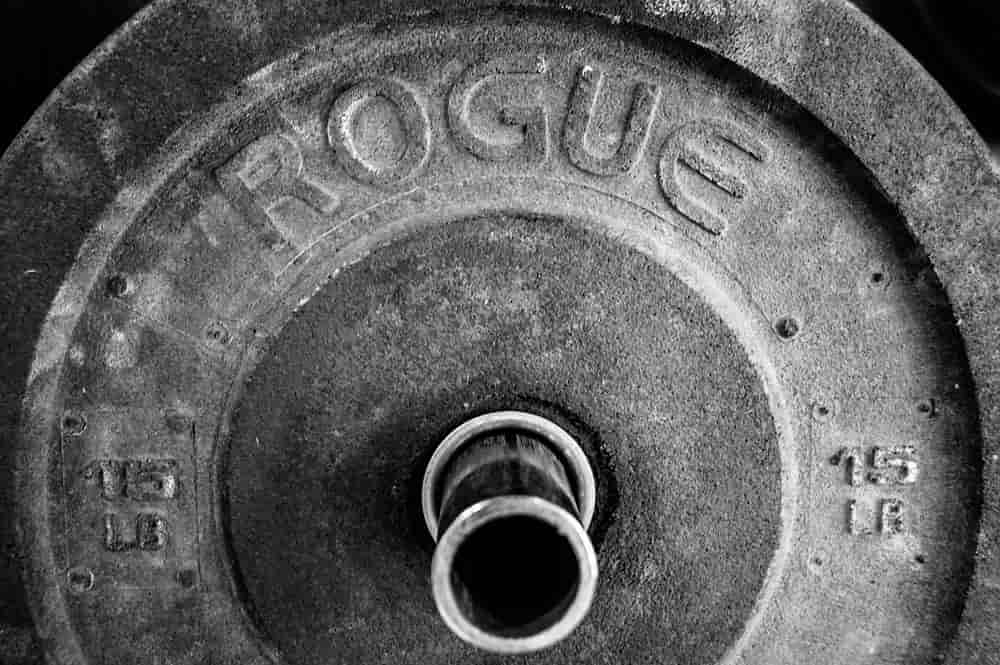
The trap bar is a funny looking piece of gym equipment.
But make no mistake—this bad boy can DO WORK.
For lifters who are tall, for those of you who want a safer way to do deadlifts, or for those of you who want to develop more power for your sport of choice, the trap bar/hex bar is a killer addition to your training.
(For more details on why I love trap bars and using them specifically for deadlifts, you can read my breakdown on the benefits of trap bars here.)
Picking up a hex bar for your home gym requires a little bit of planning.
Handle size, handle height, weight capacity, composition, even the style of the bar—all these things come into play.
Below I’ve compiled the best trap bars and hex bars for every kind of lifter.
Whether you are just getting started with one or you are an experienced power user, one of these trap bars will work for you.
Read on, and let’s get lifting.
Rogue TB-1 Trap Bar
Rogue Fitness makes some of the best fitness gear on the planet. I am a huge fan of their flat workout bench and especially their adjustable weight bench. Although their stuff typically ranks at the higher end of the cost scale, the quality matches the price tags.
The Rogue TB-1 Trap Bar, now in its second iteration, has a reduced weight profile designed to make the bar easier to move around without compromising weight capacity. The bar now comes in at around 60-pounds.
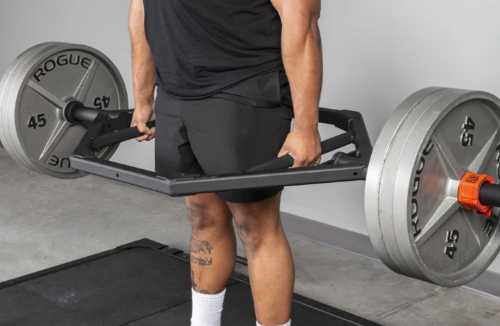
For home gym owners, being able to move the bar around easily is key as it makes it rackable (perfect for neutral grip pressing, for example). This kind of versatility isn’t so important for commercial gyms, but the home gym owner, typically facing a space crunch, will appreciate the multi-functional capability of the bar.
The sleeves can load up plenty of plates (16” of loadable space), thicker bumper plates included. The knurled and neutral handles create a comfortable and secure grip.
That said, there is only one set of handles on the Rogue TB-1 Trap Bar. As a taller person, I enjoy having the second, elevated set of handles available to me.
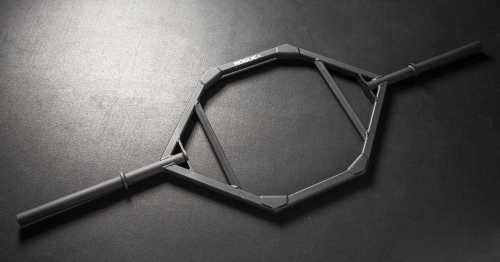
Rogue Fitness TB-2 Trap Bar
If you just finished my breakdown of the Rogue Fitness TB-1, you are going to understand why I like the TB-2. That second pair of handles, giving me an option of a regular height pull and an elevated pull, makes it a winner for me.
Besides the extra raised handles (which provide an additional 8” of clearance), the TB-2 is basically exactly the same as the TB-1. The TB-2 weighs the same, around 60-pounds.
Made in the USA with American and Canadian steel, with 16” of loadable sleeve space, and that sexy black powder coating that is typical of Rogue Fitness products.
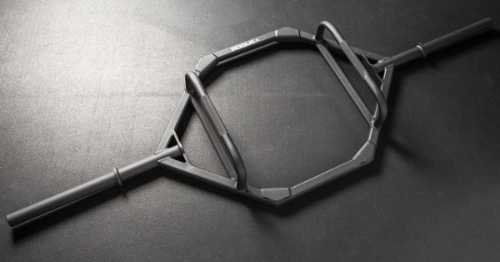
CAP Barbell Olympic Trap Bar
Barbells generally don’t come with a lot of style options (it’s a chrome or steel bar, after all…). The CAP Barbell Trap Bar, available in a wide variety of colors, gives you some choices when it comes to what you want your trap bar to look like.
For those of us building our dream (or at least, ideal) home gym, this is a nice perk. But in terms of raw functionality, the CAP Barbell delivers.
Weighing in at 28-pounds, the trap bar is rated for up to 500-pounds.
Made of high-grade steel and held together with steel carbon bolts, the CAP Barbell Trap bar has two sets of handles (at different heights—the elevated ones are perfect for taller lifters) and is priced extremely reasonably.
Depending on the seller and color, they cost approximately $100, making them a stylish and well-priced addition to your home gym.
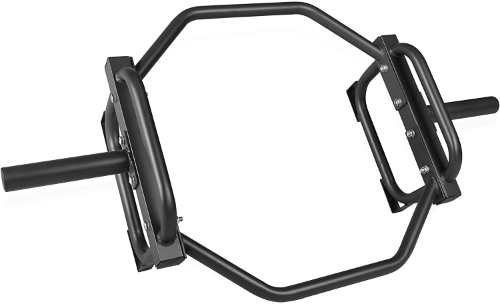
Everyday Essentials Olympic Hex Bar
The Everyday Essentials Hex Bar is just like the ones you are most likely to see at your local neighborhood gym.
The bar weighs 45-pounds, is made constructed of heavy-duty steel (no bolts and the bar is not hollow), and is rated to handle 1,000-lbs of weight plates.
The sleeves are smooth and extra long to accommodate all the weights you can find, and two sets of handles, one extra raised, means you can get a proper grip on the bar.
Priced affordably (just under $100), the Everyday Essentials provides all of the heavy duty perks of a high-performance trap bar with a completely reasonable price tag.
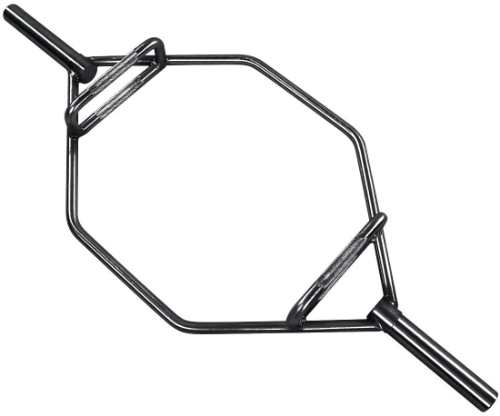
Cap Barbell Super Trap Bar
What’s better than a trap bar? A super trap bar!
All jokes aside, Cap Barbell’s Super Hex/Trap Bar is fantastic.
You get the dual benefits of a high weight capacity (up to 750-pounds for you Hulk-certified lifters) and a variety of grip thickness with a revolving tri-grip.
Yup, the grill literally rotates around, giving you a choice of 30mm, 38mm, or 45mm grip thickness. Seems pretty super to me.
In addition, the sleeves (10-inches long) are elevated enough off of the ground that loading and unloading plates isn’t such a struggle.
Altogether, Cap Barbell nails it with this thing, which looks great, has a wide range of grips for multiple users (or the same user who likes to play around with different grips), and a durable powder-coating finish that prevents rust and looks great in your home gym.
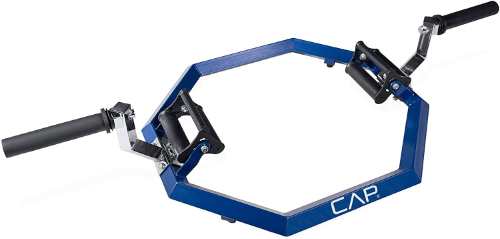
Sunny Health & Fitness Olympic Hex Bar
Sunny Health and Fitness make a lot of budget-friendly equipment for home gyms.
Although their gear tends to be on the lower side of weight capacity (and by extension, quality), and for less serious lifters, the price point and load-bearing capacity of their hex bar make it hard to argue against.
The 9.5-inch sleeves can be loaded with up to 750-pounds. Knurled handles provide a secure and comfortable grip that won’t tear up your hands too much.
(That said, if your palms get really sweaty while working out, and you don’t want to rip up your hands with blisters, use lifting chalk, weight training gloves, or even lifting straps to keep your grip slip-free.)
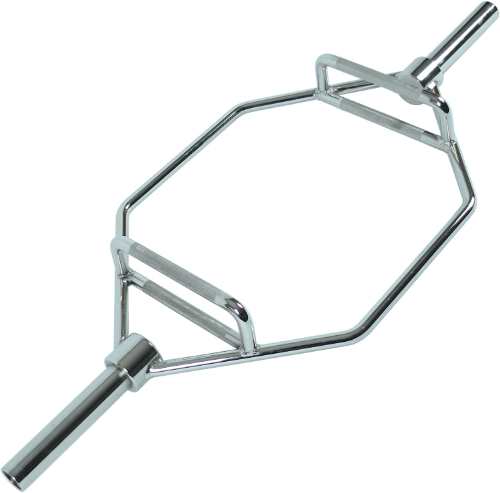
Trap Bars – Buyer’s Guide
The best part about traps bars, and specialty barbells in general, is that they can inject a shot of something new and different into your training.
Trap bars are great as they can provide an alternative grip and lift experience for those who want something different from a traditional barbell. They are also a better alternative to barbell deadlifts for gymgoers and athletes who want to develop more power1.
Fun fact: Trap bars were initially known as the Gerard Trap Bar, after its founder, Al Gerard. The bar is so named after their shape—trapezoidal—and not because they can be used for shrugs. Most trap bars nowadays are made with a hexagonal shape.
And just as there are a ton of different uses for trap bars, there are a number of things to look for when choosing the one that matches up with your goals in the gym.
Here are the key things to keep an eye on.
? Handle Configuration
Trap bars come with either a single handlebar (per hand) or two handlebars (per hand), with a low handle and a high handle.
I’ve always preferred the double handles as they give you a little more flexibility when it comes to lifting height, and, as a taller fella, I like having a slightly elevated grab height. The high handles turn the deadlift into a modified rack pull.
Handle height also plays a role in muscle and training stimuli. High handles help you better target the hip hinge movement (best for strengthening your barbell deadlift) while lower handles recruit more quad muscle due to the increased knee flexion (best for building overall leg muscle).
Having high and low handles simply gives you more options for training.
? Knurling
The knurling is the patterned etch that helps you to better grip the trap bar and it’s found on the handles where your hand meets the bar.
Typically diamond-shaped, the knurling help keep your hands in place while executing a heavy lift, and a good knurl is key for heavy pull exercises like deadlifts.
An aggressive knurl is best suited for high-weight, low rep sets. A less aggressive knurl is better for mid to high rep sets.
The more aggressive the knurl, the quicker your skin will get chewed up and calloused by the bar.
? Handle thickness
Trap bars tend to have thicker handles compared to the shaft of a barbell.
While powerlifting barbells can inch just over 30mm thick, most trap bars take it further, often hitting the mid-30s.
The Rogue TB-1 Trap bar, for instance, has a handle thickness of 34mm.
Some trap bars have skinny and fat handles, so if you are going to be using the bar with someone who has smaller/larger hands than you, be on the lookout for the trap bars with variable handle thicknesses.
? Rackable
Do you have a power rack at home? Want to use your trap bar in conjunction with it to do presses, rack pulls with the safety provided of your spotter straps? Then look for a trap bar that is rackable.
You will instantly recognize the rackable variety by their significantly increased length compared to a “regular” hex bar. Titan Fitness’ rackable trap bar, for example, as a length of over 85”, which is nearly thirty inches longer than their Olympic Hex Bar.
If you plan on using your bar inside your power rack, keep an eye on the word “rackable” in the product description.
? Closed vs open trap bars
The O.G. trap bar is trapezoidal-shaped, designed to be stepped into. In recent years we have seen a new variant of the trap bar—one that you can walk into.
These are known as open trap bars.
This latest update on the trap bar has an open end that makes it ideal for moving around “in” the bar, making it ideal for exercises like lunges or farmer walks that require more room for your hips and legs to operate.
Although open trap bars can look like they don’t provide the same balance because of uneven weight distribution of the bar, they are properly balanced.
? Length of the plate sleeve
Because deadlifts are often done with a ton of weight, look for a trap bar that has enough space to load your bumper plates.
Bumper plates are thick and can quickly soak up all the space on the plate loading sleeve.
A Rogue 55lb bumper plate, for example, is 3.75” thick. You could only put four of these per side on the Rogue TB-1 Trap Bar (sleeve length of 16”), and you wouldn’t have enough room to secure them with a barbell collar.
Tip: When trying to figure out how many bumper plates a trap bar can hold, don’t forget to leave a few inches for a barbell collar to secure the plates.
Using the same bumper plates on other trap bars—like the Synergee Olympic Hex Bar and it’s 10” of sleeve length—would only allow you to place two 55lb bumpers on it per side.
Check the plate sleeve length before clicking on “add to cart” to make sure that you can load it up with your plates and hit those training goals.
? Bar weight
Trap and hex bars come in a staggering variety of weight options.
Unlike powerlifting and Olympic barbells, which come in at a uniform 20kg/44lbs, trap bars range widely in weight, with intro bars weighing less than 30lbs and premium, heavy-duty bars weighing as much as 75lbs!
The range in weight of trap bars is due to the extra bar material and because they are a training bar, and don’t need to be certified for competition, manufacturers can build them to their heart’s delight.
? Budget
Finally, we have the consideration of price. Barbells in general aren’t cheap, and trap bars are no exception, with entry-level options costing around $150-200.
The price slopes upwards pretty fast from there, with some of the elite trap bars costing as much as $1,000.
If you are looking to invest in a quality trap/hex bar that will last, consider putting aside $300-400 for a durable bar.
Best Trap/Hex Bars – Frequently Asked Questions
Are hex bars worth it?
Trap bars are an excellent investment for your home gym as they can be deployed for a wide variety of lifts and movements.
Although the bar looks relatively simple, it can be configured and tweaked to target different muscle groups and you can use it to bust through plateaus by laser-focusing on specific areas of your deadlift.
Because it is a specialty bar (i.e it won’t be getting used every day), and because they are designed for heavy-duty use, trap bars also have an excellent life span.
Are all trap bars the same?
Trap bars vary widely in shape and function. Unlike a regular barbell, which is generally universal in design, length and weight, trap bars come in a whole bunch of different styles.
There are open and closed trap bars, multiple hand configuration options, plate loading sleeve length, a huge range of bar weights, and even trap bars that can be racked on your power rack.
The trap bar you choose should line up with your workout goals and the equipment you have at home.
Can you deadlift more with a trap bar?
Trap bar deadlifts feel “easier” because the weight is closer to your body, placing you in a biomechanically superior position to lift it.
With the weight around you, you can exert more power and force when doing the lift, which is often why lifters can push more weight on this variation of the deadlift.
Although the conversation tends to devolve into a either/or, there should be room in your training program for both the barbell and trap bar deadlift.


